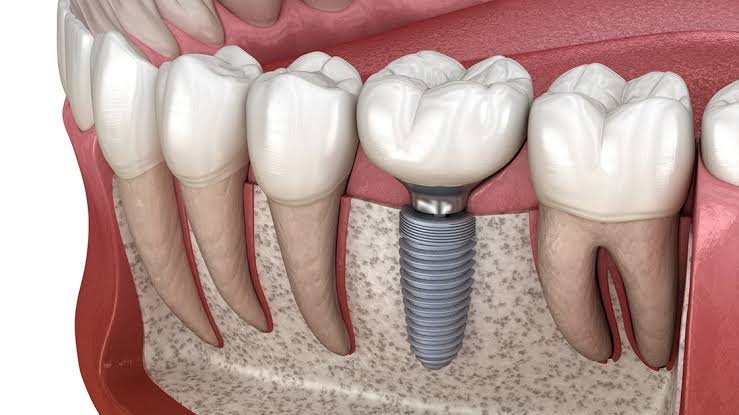Introduction
Dental implants are advanced medical devices designed to exchange lost teeth and bring back oral function. These artificial tooth roots, crafted from biocompatible constituents like titanium, are surgically embedded into the jawbone, creating a solid and sturdy foundation. Once in place, they efficiently simulate the role of natural tooth roots which offers strength and support for various dental prosthetics, including crowns, bridges, and dentures. This groundbreaking solution not only upturns the aesthetic appearance of a person’s smile but also supplements improved chewing ability and overall dental health.
Varieties of Dental Implants
1. Endosteal Implants
Endosteal implants are the mostly used type of dental implant, known for their inefficiency and reliability. These implants are surgically placed directly into the jawbone, agreeing them to integrate with the bone tissue over time. This process creates a solid and stable base for artificial teeth, ensuring stability and functionality.
Types of Endosteal Implants:
– Screw-type Implants: Characterized by their spiral design, these implants are designed to provide strong anchorage within the jawbone.
– Cylinder-type Implants: These implants feature a cylindrical shape and are also inserted into the jawbone, offering an alternative design for stability.
Ideal Candidates for Endosteal Implants:
– Patients with Sufficient Jawbone Density: Individuals who have suitable bone structure are generally the best candidates for these implants, as sufficient density is crucial intended for proper integration and support.
– Individuals Seeking a Long-Term Solution: Those looking for a permanent option to replace missing teeth will benefit from the stability and prolonged existence that endosteal implants provide.
Subperiosteal Implants
Subperiosteal implants are a generalized type of dental implant placed underneath the gum tissue while still resting on or above the jawbone surface. This approach is particularly meant for patients who has sufficient healthy jawbone density to support traditional endosteal implants, which are inserted directly into the jawbone.
Indications for Subperiosteal Implants:
– Patients with Significant Bone Loss: Subperiosteal implants are ideal for individuals who have experienced significant bone loss due to conditions such as periodontal disease, trauma, or prolonged tooth loss. Since these patients cannot be in the running for conventional implants without undergoing extensive bone grafting procedures, subperiosteal implants offer a worthwhile solution.
– Less Invasive Option: For those who prefer a procedure with less invasiveness, subperiosteal implants provide a replacement. The placement process may involve fewer surgical interventions, thus reducing recovery time and minimizing discomfort compared to more extensive bone augmentation surgeries.
Overall, subperiosteal implants serve as a vital option for reaching dental renewal in patients with negotiated jawbone structure, offering both functional and aesthetic benefits.
Zygomatic Implants
Zygomatic implants are a type of dental implant which are specifically designed for placement in the zygomatic bone, which is commonly referred to as the cheekbone. Unlike old-fashioned dental implants that are fixed in the jawbone, zygomatic implants offer a distinctive solution for individuals who experience significant bone loss in the upper jaw, making conventional implants challenging or impossible.
Indications for Zygomatic Implants:
Zygomatic implants are particularly suited for patients who face severe resorption of the jawbone due to tooth loss, trauma, or conditions such as osteoporosis. These implants are an excellent option for those who wish to escape the convolutions and potential complications associated with bone grafting procedures. By utilizing the zygomatic bone, which is typically more robust and resilient than the upper jawbone, these implants provide a vulnerable and stable foundation for dental restorations.
This innovative approach not only shortens the treatment process but also significantly lessens the time required to get a fully functional set of teeth, allowing patients to recover their oral function and visual appearance with less invasive procedures.
Benefits of Dental Implants
1. Improved Appearance:
– Dental implants are designed to look and feel like natural teeth, offering an aesthetically pleasing solution for those with missing teeth.
– They play a crucial role in maintaining the facial structure, preventing the sunken appearance that can occur when teeth are lost.
2. Boosted Functionality:
– One of the most significance of dental implants is their ability to restore full chewing capability. This allows individuals to enjoy a wider variety of foods without discomfort.
– In addition, they improve speech clearness by reducing slippage that can occur with other tooth replacement options, such as dentures, enabling smoother and more self-confident communication.
3. Durability and Longevity:
– With proper oral hygiene practices and regular dental check-ups and follow-ups, dental implants can last a generation. This makes them a cost-effective solution in the long run, as they do not call for the frequent substitutes associated with other prosthetic options.
– Implants have a high success rate, often cited at around 95%, meaning they are a reliable option for tooth replacement.
4. Preservation of Jawbone:
– Dental implants play a vital role in preventing bone loss that often follows tooth extraction. When a tooth is missing, the jawbone can begin to weaken, leading to changes in facial shape.
– By integrating with the jawbone, implants help encourage bone growth and preserve the integrity of facial structures.
5. Comfort and Convenience:
– Unlike dentures, dental implants are tightly anchored in the jaw, which inhibits any slipping or distress while eating or speaking. This offers a level of constancy that enhances the overall experience of the user.
– Additionally, there is no need for adhesives or relentless maintenance, making dental implants a suitable and hassle-free choice for those seeking a long-term solution for tooth loss.
The Dental Implant Procedure: A Detailed Overview
The drive to getting dental implants contains a sequence of wisely harmonized steps, each vital for making certain the success and longevity of the implants. Let’s have a closer look at each step of the process:
1. Initial Consultation and Planning:
The process begins with an initial consultation where your dentist will conduct a detailed dental examination. This may include a full valuation of your oral health, medical history, and specific needs. During this visit, your dentist will take X-rays and utilize advanced 3D imaging technology. These imaging techniques are essential for estimating your jawbone’s structure and density, aiding to determine the ideal placement of the implants. The dentist will also discuss your treatment options, addressing any questions or concerns you may have.
2. Implant Placement Surgery:
Once the planning phase is complete, the next step is the implant placement surgery. This process is typically performed under local anesthesia or sedation. During the surgery, a small incision is made in the gum tissue to expose the bone. A titanium implant, which serves as a substitute for the natural tooth root, is then cautiously placed into the jawbone. This titanium post will ultimately fuse with the bone during a health-giving process known as Osseo integration. The healing period typically lasts between 3 to 6 months, during which time the implant becomes securely anchored in the jawbone.
3. Abutment Placement:
After the Osseo integration process is completed and the implant is constant, the next stage involves the placement of an abutment. This small connector attached with implant and serves as a foundation for the prosthetic tooth (crown). The abutment is placed usually during a minor surgical procedure, which may also require local anesthesia. Once the abutment is secured, additional healing time is needed for the surrounding gum tissue to fully recover and adapt to the new constituent.
4. Crown Placement:
The final step in the dental implant procedure is the placement of the custom-made crown. A dental lab creates this crown based on impressions taken of your mouth, ensuring that it matches the size, shape, and color of your natural teeth. During this appointment, your dentist will carefully place the crown onto the abutment, making final adjustments to guarantee appropriate fit, alignment, and aesthetics. Once the crown is adjust in place and you are satisfied with the results, your smile makeover is complete, providing you with a functional and beautiful replacement for your missing teeth.
Throughout this entire process, your dental team will provide guidance and support, ensuring you are informed and comfortable at each stage. Dental implants are a reliable and actual solution for tooth replacement, leading to improved oral health and enhanced quality of life.
Considerations and Risks
Dental implants boast a high success rate, but it’s crucial to recognize the following factors:
Health Considerations:
– Patients with diabetes or osteoporosis must receive generalized care to optimize outcomes.
– Smoking significantly impairs healing and risks the success of the implant.
Potential Risks:
– Infection at the implant site is a serious concern that must be addressed.
– Patients should be aware of possible obstacles, including nerve damage and sinus issues, particularly with implants in the upper jaw.
Post-Procedure Care:
– Diligent brushing and flossing are essential for maintaining implant health.
– Regular dental check-ups are mandatory to monitor the implant and ensure the well-being of surrounding teeth.
Understanding the Cost of Dental Implants
The price of dental implants can fluctuate due to a variety of factors. Key concerns include:
– The number of implants needed for your specific situation
– The type of implant that is selected
– Any additional procedures that may be necessary, such as bone grafting or sinus lifts
– The geographical location of the dental practice and the expertise of the dentist
By taking these elements into account, patients can better understand the potential costs associated with dental implants.


